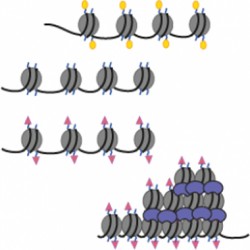By Helen Figueira
May 1, 2014
Time to read: 4 minutes
 Vitamin B3 may hold the key for treating this childhood disease.
Vitamin B3 may hold the key for treating this childhood disease.
Friedreich’s ataxia is an inherited and progressive disease, typically taking hold in childhood, affecting speech and movement. Within 10 to 20 years sufferers are confined to a wheelchair, before becoming completely incapacitated in later stages. The chronic disorder demands lifelong treatment primarily in the form of support therapies, as at present, there is no known cure. The root cause of the disease is a faulty gene that ‘switches off’ expression of the frataxin gene, essential in maintaining healthy mitochondria (the cell’s power supply). Published today, CSC Associated Investigator, Professor Richard Festenstein and his team discover a household vitamin supplement that can ‘switch on’ the frataxin gene at the epigenetic level, offering new hope in the treatment of the disease.
This is a discovery that evolved from basic science laboratory benches, whereby Festenstein’s studies not only pinpointed the epigenetic mechanism by which the frataxin gene is silenced (Saveliev, 2003), but also revealed properties in vitamin B3 (also known as nicotinamide) that stand to correct it. In 2013, applying this knowledge, Festenstein conducted preclinical studies and revealed vitamin B3 upregulated expression of frataxin in primary cells from humans, cells lines and a mouse model for Friedreich’s ataxia by ‘opening up’ the aberrantly compacted Frataxin gene making it accessible to the factors needed to activate it (Chan, 2013). Now, published in the Lancet, Festenstein takes his research to Friedreich’s ataxia patients and reveals vitamin B3 switches on frataxin gene expression in sufferers too (shown below).
Vitamin B3 is found in much of the food we eat including meat, eggs, milk, green vegetables and yeast. In adults, the recommended daily allowance is around 15 mg; yet doses in this study started from 2000 mg and escalated to 8000 mg per day, which meant monitoring safety, clinical and the neurological effects of the drug was key. “We took it very gently, starting with a low dose for one day, increasing the dose the next week and kept going on until we reached the maximum tolerated dose,” explains Professor Festenstein. What’s more, the team detected a clear-cut dose responsive relationship between the amount of vitamin administered and frataxin produced.
Despite patients producing more frataxin, the short period of the study meant no significant improvements were noted. “This is a relatively slow developing disease; it normally takes a Friedreich’s ataxia patient one year to show small changes in neurological decline, therefore, over two months, we didn’t expect to see any major improvements,” says Festenstein. While this doesn’t rule out that over a longer timescale improvements may be seen, Festenstein warns that patients should not start taking the drug yet: “We still don’t know if the drug is safe over long periods of time, or if it treats the disease.”
The next step of this journey is the trial for clinical efficacy. This entails testing on a larger patient sample, over a longer timescale; only then will it be determined whether such a readily available supplement can truly arrest the progress of the disease. The study provides proof-of-concept that other genes that are aberrantly ‘switched off’ might also be amenable to a similar approach, providing a potential novel therapeutic avenue for a growing number of genetic diseases caused by a similar ‘epigenetic’ mechanism.
YJ
Reference: Libri V, Yandim C, Athanasopoulos S, Loyse N, Natisvili T, Law P.P, Chan JP, Mohammad T, Mauri M, Tam KT, Leiper J, Piper S, Ramesh A, Parkinson MH, Huson L, Giunti P, Festenstein R. (2014). Epigenetic and neurological effects of high-dose nicotinamide in patients with Friedreich’s ataxia: an exploratory study. Lancet, 384(9942), 504-13.
The study was supported by Ataxia UK, Ataxia Ireland, Association Suisse de l’Ataxie de Friedreich, Associazione Italiana per le Sindromi Atassiche, the NIHR, the European Friedreich’s Ataxia Consortium for Translational Studies, and the Imperial Biomedical Research Centre.
The Medical Research Council has been at the forefront of scientific discovery to improve human health. Founded in 1913 to tackle tuberculosis, the MRC now invests taxpayers’ money in some of the best medical research in the world across every area of health. Twenty-nine MRC-funded researchers have won Nobel prizes in a wide range of disciplines, and MRC scientists have been behind such diverse discoveries as vitamins, the structure of DNA and the link between smoking and cancer, as well as achievements such as pioneering the use of randomised controlled trials, the invention of MRI scanning, and the development of a group of antibodies used in the making of some of the most successful drugs ever developed. Today, MRC-funded scientists tackle some of the greatest health problems facing humanity in the 21st century, from the rising tide of chronic diseases associated with ageing to the threats posed by rapidly mutating micro-organisms. www.mrc.ac.uk